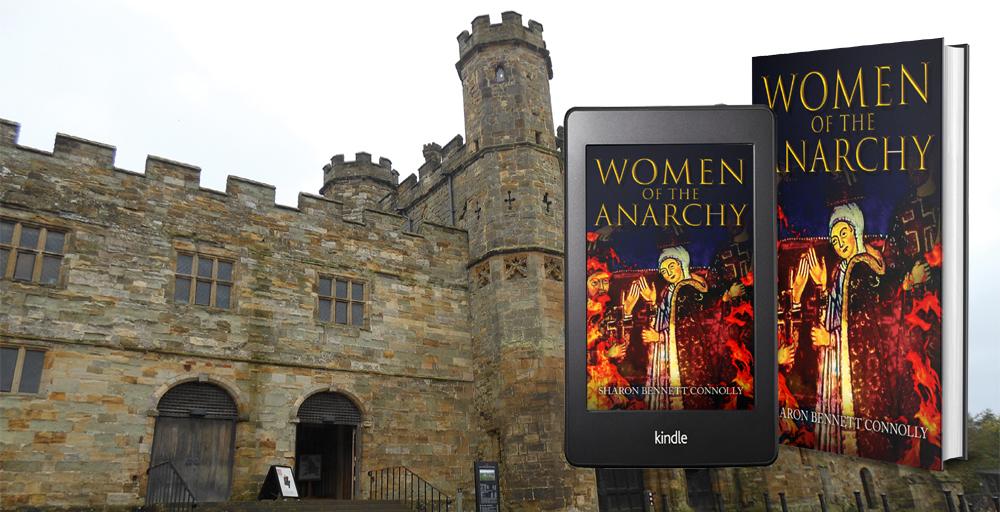As promised, here’s Part Two of Medieval She-Wolves. Charting the stories of 3 more remarkable women who have been labelled ‘she-wolves’ due to their strength and determination – and a ruthlessness born out of an impressive survival instinct.
Zoe, Empress of Constantinople

Zoe Porphyrogenita lived much of her life in relative obscurity. At the age of 50, in 1028, she was married to her father’s designated successor, Emperor Romanos III, and became empress consort when he succeeded to the throne in the same year. Zoe was described by a palace courtier, Michael Psellos, as ‘a woman of great beauty, most imposing in her manner and commanding respect … a woman of passionate interests.’
As empress consort, Zoe asserted herself. Her younger sister, Theordora, was sent to a monastery. Neglected by her husband, who had taken a mistress and refused his wife access to the treasury, Zoe took a much younger, teenage lover, Michael. Together the lovers conspired to dispose of Romanos and he was drowned in his bath in 1034.
Zoe promptly married her lover and made him Emperor Michael IV. Their marriage, however, was full of distrust and Zoe was allowed no power or say in government. Michael IV then banished Zoe to the gynaeceum, or women’s quarters. Not to be forgotten, Zoe began scheming to reclaim her throne. After she was allowed back to court, and unable to bare her own children, Zoe adopted Michael IV’s nephew, another Michael, and made him her heir. Michael IV’s life would have probably ended in the same way as his predecessor, Romanos III, drowned in the bath or with a knife in his back, had he not died of natural causes in 1041.
Michael’s nephew, Zoe’s adopted son, ascended the throne as Michael V. When Michael V was crowned, Zoe was again banished to a monastery, an act which caused an uprising in Constantinople. Michael V was deposed after only four months of disastrous rule. He was exiled to a monastery, but complaints about such lenient treatment meant that, despite Zoe’s desire to be merciful, orders were issued for his mutilation and he was blinded, an act symbolically rendering him incapable of ruling.

Now 64-years-old, Zoe was empress, once again. Her sister, Theordora, was retrieved from her monastery to rule beside her, though Zoe’s throne being placed slightly further forward, at the joint coronation ceremony, was an obvious indication of which of the sisters was in charge. In the same year, 1042, Zoe took a third husband, Emperor Constantine IX, who co-ruled the empire, with the two sisters. Constantine outlived his wife; Zoe died in 1050, aged about 72. A ruthless empress who knew what she wanted, Zoe was not afraid to dispose of her rivals – whether they be a husband or an adopted son.
Isabella of Angouleme, Queen of England
At first sight, it is easy to have sympathy for Isabella of Angouleme. When I started researching her for my forthcoming book, Ladies of Magna Carta: Women of Influence in Thirteenth Century England, I was expecting to be able to go some way to redeeming her reputation. She was married at a very young age – she was no more than 12 and may have been as young as 10 – to ‘Bad’ King John, the man who left women to starve in his dungeons and murdered his own nephew. Isabella and John were married in 1200 and, after 16 years together, they had 5 children; the youngest, Eleanor, was born in 1215.

When John died in October 1216, however, Isabella didn’t spend much time seeking to comfort and protect her children. As soon as her oldest son, Henry III, was crowned with her own ‘chaplet’, Isabella started making arrangements to go home, to her own lands in Angouleme, France. In 1217 she left England, supposedly to arrange the wedding of her daughter, Joan, but she never returned. Joan had been betrothed, at the age of 4, to Hugh X de Lusignan, Count of La Marche and the son of Hugh IX de Lusignan (the man who had been betrothed to Isabella before John married her).
In 1220, however, in a scandalous about-face Hugh IX repudiated Joan and married her mother, his father’s former betrothed. And poor 9-year-old Joan’s erstwhile betrothed was now her step-father!
But worse was to come…
Instead of being sent back to England, as you would expect, Joan went from being Hugh’s betrothed – to being his prisoner. She was held hostage to ensure Hugh’s continued control of her dower lands, and as a guarantee to the transfer of his new wife’s dower. England, on the other hand, was withholding Queen Isabella’s dower against the return of Joan’s dower lands.
Isabella wrote to her son, Henry III, to explain and justify why she had supplanted her own daughter as Hugh’s bride, claiming that his ‘friends’ were worried about Joan’s youth and forcing Hugh to repudiate the English princess in favour of a French bride who was old enough to bear him a son. Isabella had married Hugh to stop him going over to the French and to guarantee his allegiance to her son.
Ironically, the proposed union of Hugh IX and Isabella, and of their lands, was the reason John had married Isabella in the first place – to prevent the lands of La Marche and Angouleme combining and challenging Plantagenet superiority in the region. Little Joan was returned to England towards the end of 1220, but the arguments over Isabella’s English lands continued and they were confiscated, for a short time, in 1221.
Isabella would not retire in peace, however, and in 1224 she and Hugh betrayed Henry by allying themselves with the King of France. In exchange for a substantial pension, they supported a French invasion of Poitou (the lands in France belonging to the King of England, her son). Although she reconciled with Henry in 1230, Isabella and Hugh continued to play the kings of France and England against each other, always looking for the advantage. In 1242, for example, when Henry III invaded Poitou, Hugh X initially gave support to his English stepson, only to change sides once more. Isabella herself was implicated in a plot to poison King Louis IX of France and his brother, only to be foiled at the last minute.
As contemporaries described her as ‘more Jezebel than Isabel’, accused her of ‘sorcery and witchcraft’, Isabella of Angouleme’s reputation as a heartless mother and habitual schemer seems set to remain. With little to recommend her, she stands out as a She-wolf with an impressive ruthless streak, even against her own son.
Isabella of France, Queen of England

Isabella of France was the wife and queen of Edward II of England. In 1325, Isabella went on a diplomatic mission to France to negotiate terms with her brother, the French king Charles IV, who had seized Edward’s lands in France. Isabella saw an opportunity to take a stand against the unfairness of her situation. Ignored, spied on and persecuted by her husband’s favourite, the hated Hugh Despencer, and after 17 years of marriage, Isabella refused to return home. Isabella took to wearing widow’s weeds and claimed:
‘I feel that marriage is a joining together of man and woman, maintaining the undivided habit of life. Someone has come between my husband and myself, trying to break this bond. I protest that I will not return until this intruder has been removed but, discarding my marriage garment, I shall assume the robes of widowhood and mourning until I am avenged of this Pharisee.’
Isabella and the Strange Death of Edward II by Paul Doherty
With her son Edward, the heir to the throne, in her in France, and with the help of her close friend and adviser – and, quite possibly, her lover – Roger Mortimer, Isabella started attracting support from the disappointed and disillusioned of Edward’s subjects. In 1326, she launched the invasion of England that would see her husband fleeing for his life in the face of her advancing army. Edward and Hugh were captured near Llantrisant in Wales. Edward was sent to imprisonment in Berkeley Castle.
Hugh Despencer was taken before a military tribunal in Hereford, blamed for the collapse of the queen’s marriage and humiliating Isabella, and seizing her wealth and estates, he was given no right to reply. His guilt was a foregone conclusion. Paraded through the city of Hereford, with a crown of nettles on his head and all manner of things thrown at him, before being dragged on a sled to the town square, where Despencer suffered the full horror of a traitor’s death. He was hanged from a specially-erected gallows, fifty feet high; cut down whilst still alive, his intestines were cut out and burned before his eyes, before his head was cut off to end his agony.
Despencer’s death demonstrated the anger Isabella felt towards her husband and his favourite. Edward’s death may well have been just as gruesome – or not at all. Historians are divided about what happened to Edward II. Some claim he escaped to the continent, dying years later in Italy, while others are convinced that he was killed in Berkeley Castle, although probably not by a red-hot poker up his bum. Whatever happened to Edward, Isabella’s revenge was complete; Despencer had been utterly destroyed and Edward was deposed and replaced with his son, the 14-year-old Edward III.

For 3 years Isabella and Mortimer ruled England, only to be themselves deposed by Edward III when he turned eighteen; their own arrogance and mismanagement of England causing their downfall. Mortimer was hanged at Tyburn and Isabella spent her remaining years in comfortable house arrest, the She-Wolf who had launched an invasion of England and deposed – and possibly murdered – her husband, only to be deposed herself.
Zoe, Isabella of Angouleme and Isabella of France have been much maligned throughout history. Their stories have concentrated on the ruthlessness of their actions, rather than how they themselves had been treated by the men around them. If we turn it around, it is far easier to sympathise with women who were used as pawns in an Empire, or child brides or endured troubled marriages. Just as with Æthelflæd, Eleanor of Aquitaine and Isabeau of Bavaria (see Medieval She-Wolves from Part One), they fought for what they wanted, often against impossible odds, and achieved much. At a time when the perceived main purpose of a wife was to produce and raise children, these women made a remarkable imprint on history that has ensured their stories are still being told today.
Selected Sources:
The Oxford Companion to British History Edited by John Cannon; The Plantagenets, the Kings who Made England by Dan Jones; History Today Companion to British History Edited by Juliet Gardiner and Neil Wenborn; Brewer’s British Royalty by David Williamson; Britain’s Royal Families, the Complete Genealogy by Alison Weir; The Plantagenet Chronicles Edited by Elizabeth Hallam; The Mammoth Book of British Kings and Queens by Mike Ashley; The Plantagenets, the Kings that made Britain by Derek Wilson; England Under the Norman and Angevin Kings by Robert Bartlett; http://www.britannica.com; oxforddnb.com; finerollshenry3.org.uk; The Anglo-Saxon Chronicles by Michael Swanton; The Anglo-Saxon Chronicle by James Ingram; Chronicles of the Kings of England, From the Earliest Period to the Reign of King Stephen, c. 1090–1143 by William of Malmesbury; The Chronicle of Henry of Huntingdon by Thomas Forester; Alfred the Great by David Sturdy; Britain’s Royal Families, the Complete Genealogy by Alison Weir; The Wordsworth Dictionary of British History by JP Kenyon; The Anglo-Saxons in 100 Facts by Martin Wall; Kings, Queens, Bones and Bastards by David Hilliam; Mercia; the Rise and Fall of a Kingdom by Annie Whitehead.
Images courtesy of Wikipedia
A version of both parts of Medieval She-Wolves first appeared in the 2019 edition of All About History magazine. Isabella of Angouleme’s story is discussed in greater detail in my forthcoming book, Ladies of Magna Carta.
My Books:
Signed, dedicated copies of all my books are available through my online bookshop.
Out Now! Women of the Anarchy
Two cousins. On the one side is Empress Matilda, or Maud. The sole surviving legitimate child of Henry I, she is fighting for her birthright and that of her children. On the other side is her cousin, Queen Matilda, supporting her husband, King Stephen, and fighting to see her own son inherit the English crown. Women of the Anarchy demonstrates how these women, unable to wield a sword, were prime movers in this time of conflict and lawlessness. It show how their strengths, weaknesses, and personal ambitions swung the fortunes of war one way – and then the other.
Available from Bookshop.org, Amberley Publishing and Amazon UK.
Coming on 15 June 2024: Heroines of the Tudor World
Heroines of the Tudor World tells the stories of the most remarkable women from European history in the time of the Tudor dynasty, 1485-1603. These are the women who ruled, the women who founded dynasties, the women who fought for religious freedom, their families and love. These are the women who made a difference, who influenced countries, kings and the Reformation. In the era dominated by the Renaissance and Reformation, Heroines of the Tudor World examines the threats and challenges faced by the women of the era, and how they overcame them. From writers to regents, from nuns to queens, Heroines of the Tudor World shines the spotlight on the women helped to shape Early Modern Europe.
Heroines of the Tudor World is now available for pre-order from Amberley Publishing and Amazon UK.
Also by Sharon Bennett Connolly:
King John’s Right-Hand Lady: The Story of Nicholaa de la Haye is the story of a truly remarkable lady, the hereditary constable of Lincoln Castle and the first woman in England to be appointed sheriff in her own right. It is is available from King John’s Right-Hand Lady: The Story of Nicholaa de la Haye is the story of a truly remarkable lady, the hereditary constable of Lincoln Castle and the first woman in England to be appointed sheriff in her own right. Available from all good bookshops or direct from Pen & Sword Books, bookshop.org and Amazon. Defenders of the Norman Crown: The Rise and Fall of the Warenne Earls of Surrey tells the fascinating story of the Warenne dynasty, from its origins in Normandy, through the Conquest, Magna Carta, the wars and marriages that led to its ultimate demise in the reign of Edward III. Available from Pen & Sword Books, Amazon in the UK and US, and Bookshop.org.
Ladies of Magna Carta: Women of Influence in Thirteenth Century England looks into the relationships of the various noble families of the 13th century, and how they were affected by the Barons’ Wars, Magna Carta and its aftermath; the bonds that were formed and those that were broken. It is now available in paperback and hardback from Pen & Sword, Amazon, and Bookshop.org. Heroines of the Medieval World tells the stories of some of the most remarkable women from Medieval history, from Eleanor of Aquitaine to Julian of Norwich. Available now from Amberley Publishing and Amazon, and Bookshop.org. Silk and the Sword: The Women of the Norman Conquest traces the fortunes of the women who had a significant role to play in the momentous events of 1066. Available now from Amazon, Amberley Publishing, and Bookshop.org.
Alternate Endings: An anthology of historical fiction short stories including Long Live the King… which is my take what might have happened had King John not died in October 1216. Available in paperback and kindle from Amazon.
Podcast:
Have a listen to the A Slice of Medieval podcast, which I co-host with Historical fiction novelist Derek Birks. Derek and I welcome guests, such as Bernard Cornwell and Elizabeth Chadwick, and discuss a wide range of topics in medieval history, from significant events to the personalities involved.
*
Don’t forget! Signed and dedicated copies of all my books are available through my online bookshop.
For forthcoming online and in-person talks, please check out my Events Page.
You can be the first to read new articles by clicking the ‘Follow’ button, liking our Facebook page or joining me on Twitter and Instagram.
*
©2020 Sharon Bennett Connolly FRHistS





Very good analysis.
LikeLike
Thank you, Carol.
LikeLike
Another one of your fascinating historical posts. I actually have quite a bit of sympathy for these women, regardless of how history chooses to regard them. History is often written by men after all, so it’s probably easy to forget that women were not only treated as property but they also learned how to scheme and how to manipulate from the very men who treated them thus. I admire strong women and even though I don’t agree with killing, it was a different time and they did what they had to to survive. I was particularly fascinated by Zoe’s story. Thank you for sharing more amazing tales of these women.
LikeLike
I totally agree. I’ve struggled with the She-Wolves label and prefer to look at them as strong women who knew their own mind. They each had their weaknesses, but they also had incredible strength in wanting to go their own way.
LikeLiked by 1 person